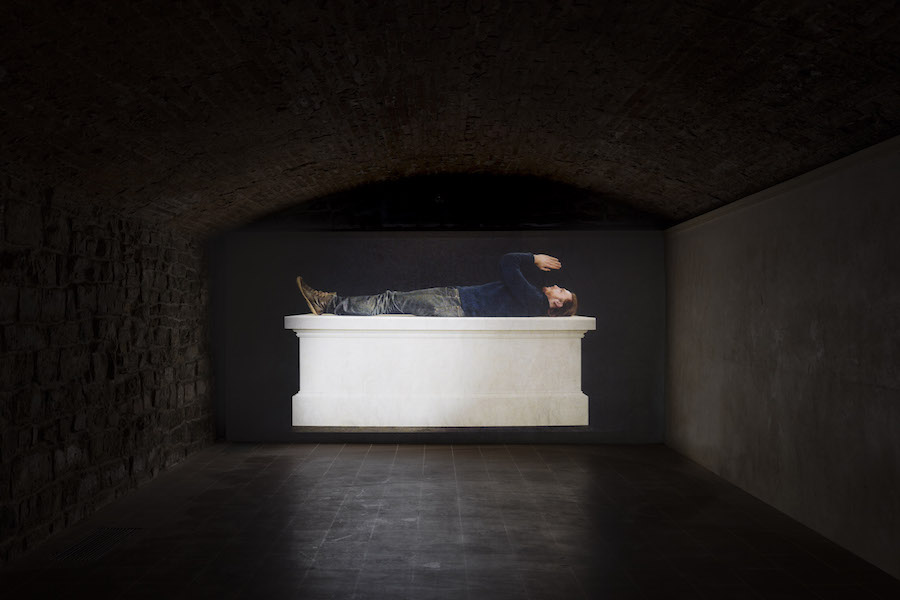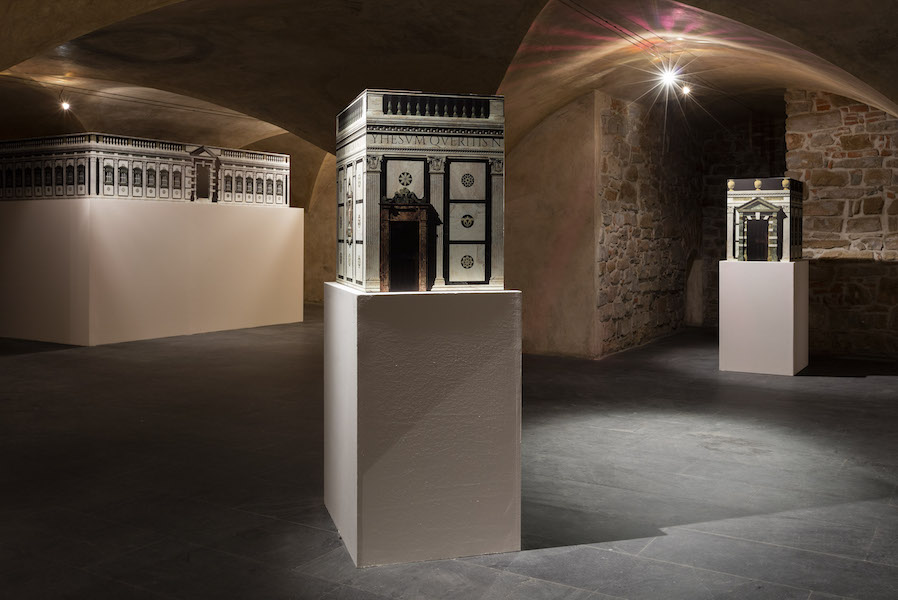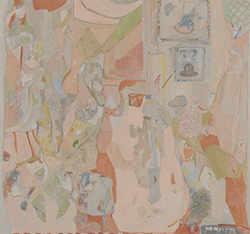[nemus_slider id=”51601″]
(Scroll down for the English version)
Fino al 20 febbraio 2016 il Museo Marino Marini ospita Studies in Mannerist Decomposition, la prima personale di Pablo Bronstein in un’istituzione museale italiana. La mostra, curata da Alberto Salvadori e Leonardo Bigazzi, è composta da una nuova serie di disegni e modelli 3D ispirati alla Cappella Rucellai di Leon Battista Alberti, insieme ad un video del 2010 e una selezione di disegni fatti fra il 2007 e il 2014.
Abbiamo fatto alcune domande a Pablo Bronstein.
ATP: La tua ricerca si concentra sulla ri-elaborazione degli elementi stilistici e decorativi dell’architettura e del teatro in Europa, dal Rinascimento ad oggi. Quali sono state le tue ispirazioni principali per questa mostra?
Pablo Bronstein: Mi sono concentrato prevalentemente su una struttura dell’architetto rinascimentale Alberti, il mausoleo Rucellai, che è collocato all’interno di una cappella laterale, nel museo Marino Marini. La struttura è completamente unica, un cimelio in ottime condizioni, e non un oggetto banale – dato che è relativamente sconosciuto al pubblico generale. Infatti non è stata incorporata in un percorso turistico e la sua immagine non è messa eccessivamente in evidenza. Ma ciò che trovo particolarmente interessante è che nonostante sia stata progettata come un monumento interno, sempre per il luogo dove si trova adesso, la struttura simula un edificio intero. È una chiesa in miniatura, perciò ha una completezza e una perfezione che vengono meno nella vera architettura rinascimentale, quando effettivamente costruita. È come guardare una forma perfetta nella mente di un architetto del Rinascimento – incondizionata dalla realtà. Il monumento inoltre si rifà direttamente, sia nella forma che nel nome, al ben più famoso monumento interno che simula una chiesa: il Santo Sepolcro di Gerusalemme. Il monumento è stato concepito nel XV secolo e chiaramente a quel tempo non c’erano descrizioni molto accurate della struttura di Gerusalemme da poter usare come riferimento. Perciò, quello di Firenze, è in parte una versione idealizzata della rappresentazione di una chiesa, anch’essa idealizzata. Con un ragionamento architettonico di una complicatezza così intensa e di superba esecuzione, ci troviamo di fronte a un emblema del Rinascimento di fantastica bellezza ma ci ritroviamo anche di fronte ad un giocattolo – con ogni connotazione positiva e negativa che la parola implica. Tuttavia, mi sono concesso anche il piacere di fare un completo scempio della perfetta struttura rinascimentale. I disegni a inchiostro sviluppano ulteriormente quest’idea e i monumenti risultano profondamente alterati. Il primo disegno raffigura il Rucellai ri-assemblato a Roma, all’interno di un grande monumento funebre barocco. È usato come base sulla quale si aggiungono altre architetture e viene trascurato. Il secondo disegno di grande formato è una scena urbana del XVII secolo che raffigura una parata con carri festivi e allegorici. Qui il Rucellai diventa un oggetto vagante d’intrattenimento benché sia popolare fra le folle, come un emblema della città, ma pur sempre un frammento d’architettura rimosso dal magistrale contesto dell’Alberti. La serie più piccola di disegni in verde è una sorta di umiliazione conclusiva per il capolavoro rinascimentale, nella quale frammenti del monumento sono stati incorporati in vistosi ornamenti da giardino. Ricavo del piacere da questo atto d’immaginaria distruzione, però mi piace pensare anche che i frammenti sono lì all’interno del disegno e possono essere trovati.
ATP: Hai creato una storia immaginaria dell’opera di Alberti. Potresti accennarmi qualcosa su questa storia e su come sei riuscito a svilupparla? Qual è stato il tuo punto di partenza?
PB: Ci sono così tanti dottorati di ricerca noiosi sul tempietto Rucellai. Il mondo di Alberti è uno di quelli in cui non volevo proprio scavare a fondo – per non entrare in una conversazione arcana sull’uso corretto di un ordine particolare, o sul significato di un tipo di decorazione in una cornice ecc… ecc… Non ha alcun reale interesse per nessuno al di fuori dei ricercatori. Il mausoleo Rucellai ha una struttura così ricca e perfetta che sarebbe stato folle cercare di analizzarla veramente, così l’ho affrontato nel modo opposto: mi sono chiesto come sarebbe stato il monumento se non fosse stato conservato in modo perfetto, come sarebbe stato se una serie di vanitosi architetti di second’ordine avesse provveduto a restaurarlo o ad abbellirlo nel XVI secolo. Come sarebbe stato se l’armonia e la completezza dell’opera di Alberti fossero state “migliorate” dalle successive generazioni, convinte che la struttura fosse troppo semplice o antiquata. Naturalmente questo comporta che la mostra sia proprio uno dei desideri umani di adattare e cambiare l’architettura, di seguire la moda, e credo che racchiuda un elemento di pathos. Tuttavia, mi sono concesso anche il piacere di fare un completo scempio della perfetta struttura rinascimentale.
ATP: Per questa mostra hai usato stampe 3D. Come si relazionano con i tuoi disegni a mano altamente raffinati?
PB: Le stampe sono incollate su strutture ampie e molto semplici – rivestono dei modelli, in modo molto simile alla struttura originale di Alberti, che è rivestita in marmo, ma è anche un modello di costruzione. Però hanno anche un processo di lavoro molto impegnativo – richiedono a me e alla mia assistente tempi molto più lunghi di quanto impieghi a mano a fare disegni dettagliati ad inchiostro. Questo perché gli elementi 3D devono essere elaborati ad un grado di logica o di coerenza. Per poter migliorare la struttura di Alberti, dobbiamo prima renderizzarla accuratamente – questo è più difficile di quanto sembri. Per il mio lavoro, inoltre, uso di rado materiali totalmente trovati. Mi comporto sempre come un architetto e di fatto progetto gli elementi ornamentali, anche se naturalmente uso molti materiali di riferimento. Questo richiede tempo e molto lavoro da parte mia e della mia assistente Skyla, che fa la modellazione 3D. Il processo non è molto diverso dal disegnare architettura, dato che c’è l’elemento ‘design’ in comune e c’è anche questo stesso ruolo, nel quale mi comporto da architetto lavorando per un particolare cliente, nonostante io sia entrambe le persone, naturalmente. Le due strutture di grande formato nella mostra prendono come punto di partenza la cappella Rucellai e i motivi vengono utilizzati per creare architetture di larga scala. Un’espansione orizzontale della struttura di Alberti allude a palazzi manieristici, mentre un’espansione verticale e una moltiplicazione sembrano fondamentalmente un condominio della 5th Avenue o un grande magazzino. Tutta questa moltiplicazione di elementi è molto facile al computer – e veramente molto impegnativa a mano. In questo caso, inoltre, le stampe si collegano al lavoro di Fornasetti, che in modo simile ha stampato motivi architettonici rinascimentali su mobili bar e portaombrelli. Fondamentalmente sia le stampe 3D che i disegni a mano sono veicoli di un modello di design.
ATP: La mostra include anche il tuo video del 2010 sulla “sprezzatura”, oltre ad una selezione di disegni dal 2007 al 2014. La tua ricerca ha una forte connessione con una ri-elaborazione del passato. Anche se qui stiamo parlando di diverse scale temporali, come vedi oggi questi tuoi lavori precedenti?
PB: Ho degli interessi molto consistenti e frequentemente rivedo lo stesso materiale originale, ma ci sono aspetti tecnici che variano dai lavori precedenti. Le opere fatte dieci anni fa hanno meno competenza tecnica ma hanno anche un tipo di concentrazione che in seguito si è persa – anche se questo può essere qualcosa di invisibile a chiunque altro, ma piuttosto un ricordo di come ho fatto quelle opere. Col passare degli anni ho sviluppato un linguaggio che possiede una certa quantità di logica interna, ma il processo assai difficile di forgiarlo dalle stronzate personali che ho nella mia testa è qualcosa che solo una versione di me più giovane avrebbe potuto fare. Di recente ho esposto un disegno del 2003 in una mostra a Londra e mi è sembrata una cosa molto nevrotica, anche se penso che a tutti gli altri sembrasse solo malfatto. Inoltre noto che col passare degli anni non ho fatto solo molti disegni ma ormai anche molti video (due sono esposti nella mostra adesso), molti libri, molte performance e istallazioni. Quest’insieme di materiali ha reso possibile allestire mostre in spazi espositivi più ampi, dato che c’è più materiale fra cui scegliere, e non devo perdere la testa per riempire tutto. Questo naturalmente ti suonerà come ovvio e inevitabile.
(Traduzione dall’inglese a cura di Gabrio Micheli)

From December 12 to February 20 Museo Marino Marini presents Studies in Mannerist Decomposition, first solo show by Pablo Bronstein in an Italian institution. The exhibition, curated by Alberto Salvadori and Leonardo Bigazzi, consists of a new series of drawings and 3d models inspired by Leon Battista Alberti’s Rucellai Chapel, along with a video from 2010 and a selection of drawings made between 2007 and 2014.
We asked some questions to Pablo Bronstein.
ATP: Your research focuses on the re-elaboration of stylistic and decorative elements from European architecture and theatre from the Renaissance to our time. What have been your main inspirations for this exhibition?
Pablo Bronstein: This exhibition has concentrated largely on a structure by the Renaissance architect Alberti, the Rucellai mausoleum, which is housed in a side-chapel in the museo Marino Marini. The structure is a remarkable survivor, completely unique, in wonderful condition, and not a cliched object, as it is relatively unknown to the general public, and so has not been incorporated into a tourist trail or over-exposed as an image. But what I find particularly interesting about it is that although it was always designed as an interior monument, and always for the space in which it is now, the structure mimics a complete building. It is a miniature church, and so has a completeness and perfection which real Renaissance architecture inevitably lacks when it is actually constructed. It is like looking at a perfect form in the mind of a renaissance architect – uncompromised by reality. The monument also refers directly, both in form and name, to a far more famous internal monument which mimics a church – the Holy Sepulchre in Jerusalem. At the time the building was conceived in the 15th century, there were of course no really accurate descriptions of the Jerusalem structure to use as reference, and so the monument in Florence is partly an idealized version of a representation of an idealized church. With such a richly complicated architectural reasoning, and superb execution we are left with a fantastically beautiful emblem of the Renaissance, but we are also left with a toy – with all the positive and negative connotation the word implies.
But I also gave myself the pleasure of completely butchering a perfect Renaissance structure. The ink drawings carry this idea a little further, and see the monument radically altered. The first drawing imagines the Rucellai re-assembled in Rome, within a huge baroque funerary monument. It is used as a base on which further architecture is added, and it is ignored. The second large drawing is a 17th century urban scene of a festival with carts and floats, in which the Rucellai has become a traveling piece of entertainment, albeit one popular with the crowds – a sort of emblem for the city, but nonetheless, a piece of architecture removed from Alberti’s masterful context. The small series of drawings in green is a sort of final humiliation for the Renaissance masterpiece, in which fragments of the monument have been incorporated into garish garden ornaments. I take some pleasure in this act of imagined destruction, but I also like to think that the fragments are there within the drawing, and they can be found.
ATP: You created an imaginary history of Alberti’s work. Could you tell me further about this story and how you managed to developed it? Which was your starting point?
PB: So many boring phd studies of the Rucellai exist. The world of Alberti is one which I didn’t really want to delve into – to get into an arcane conversation about the correct use of a particular order, or the meaning of a type of motif in a cornice etc etc. This is not something that has any real interest to anyone beyond the scholars. The Rucellai mausoleum is so perfect and rich a structure that it would have been foolish to really try to analyse it, and so I took the opposite approach, and asked the question of what the monument would have looked like had it not been perfectly preserved> what it would have looked like if a series of vain, second-rate architects had made ‘improvements’ or embellishments to it in the 16th century. What it would have looked like if the harmony and completeness of Alberti’s work had been ‘upgraded’ by subsequent generations believing the structure to be too simple, or too outdated. This of course implies that the show really is one of people’s very human desires to adapt and change architecture, to follow fashion, and there is an element of pathos to the work I think. But I also gave myself the pleasure of completely butchering a perfect Renaissance structure.
ATP: For this show you used 3d prints. How do these relate with your highly refined hand drawings?
PB: The prints are pasted onto large and very simple structures – they clad modellos, much like the original Alberti structure, which is clad in marble, but is also itself a model building. But they also have a very labour-intensive process – they take me and my assistant a lot longer to do than it takes me to make a detailed drawing in ink by hand. This is because the 3d element has to be worked out to a logical or coherent point. In order to amend the Alberti structure, we have to first render it accurately – this is harder than it sounds. My work also rarely uses completely found elements. I always act like an architect, and so actually design the ornamental elements myself, even though I of course use a lot of reference material. This takes time, and a lot of back and forth with my assistant Skyla, who does the 3d modelling. The process is not so dissimilar from the act of drawing architecture, as there is the element of design in common, and there is also therefore this same role-play, in which I act like an architect working for a particular client, though both of these are myself of course. The two large structures in the show take the Rucellai chapel as a starting point and use the motifs to create large-scale architecture. A horizontal expansion of the Alberti alludes to Mannerist palazzi, and a vertical expansion and multiplication which ultimately looks like a 5th Avenue apartment building or department store. All of this multiplication of elements is very easy on the computer – and very very laborious by hand. The prints in this case also connects to the work of Fornasetti, who similarly printed Renaissance architectural motifs onto drinks cabinets and umbrella bins. Ultimately both the 3d and the hand-drawn are standard ‘design’ vehicles.
ATP: The show also includes your 2010 video about “sprezzatura”, along with a selection of your drawings from 2007 to 2014. Your research has a strong connection with a re-elaboration of the past. Even if we’re talking here about different time scales, how do you see today these old artworks of yours?
PB: I have very consistent interests, and frequently revisit the same source-material, but there are technical aspects that vary with the older works. The works made ten years ago have less technical expertise, but they also have a kind of concentration which is subsequently lost – though this may be something that is not visible to anyone else, but rather more how I remember making those works. Over the years I have developed a language which has a certain amount of internal logic, but the very difficult process of forging this out of the personal crap in my head is something only a younger version of myself could have done. I recently showed a drawing from 2003 in a show in London, and it looked to me like a very neurotic thing, though I think to everyone else it just looked clumsy. I also notice that over the years I have made not only lots of drawings, but by now also lots of videos (there are two in the show now), lots of books, lots of performances and installations. This inventory has made it easier to mount shows in larger exhibition spaces as there is more material to choose from, and I don’t have to panic so much about filling everything. This must sound obvious, and inevitable of course.











